Strength Performance and Microstructures of Alkali-Activated Metakaolin and GGBFS-Based Mortars: Role of Waste Red Brick Powder Incorporation
Abstract
1. Introduction
2. Experimental Procedures
2.1. Raw Materials and Mixtures Proportioning
2.2. Test Methods
3. Results and Discussion
3.1. Workability Performance
3.2. Mechanical Properties
3.2.1. Effect of WRBP on Bulk Density
3.2.2. Effect of WRBP Content on Compressive Strength
3.2.3. Effect of Replacement Type (Scenario) on Strength Properties of AAMs
3.2.4. Influence of Curing Temperatures on Strength Properties of AAMs
3.2.5. Relationship between Bulk Density and CS of AAMs
3.3. Chemical Durability and Microstructures Characteristics
3.3.1. Effect of WRBP on Efflorescence and Visual Appearance of Mortars
3.3.2. XRD Analysis
3.3.3. SEM Images
4. Conclusions
- The addition of WRBP in the alkali-activated matrix as binder (GGBFS+MK) or fine aggregates (silica sand) significantly affected the workability performance wherein the flow of the fresh mortar was decreased with the increase in WRBP content.
- The bulk density of the studied mortars was significantly influenced by the variation in WRBP content and curing regime. The replacement of GGBFS and MK by increasing the level of WRBP from 0 to 45% led to an increase in the bulk density of the mortars. Contrarily, the inclusion of WRBP as silica sand replacement led to a decrease in the bulk density of the prepared specimens. In short, the bulk density of the AAMs was considerably influenced by the curing regime wherein the specimens cured at higher temperature showed lower density.
- Replacement of GGBFS and MK by 15% of WRBP led to an enhancement in the compressive strength performance of the mortar by 30.7%. However, further increase in the WRBP content up to 45% led to a significant drop in the compressive strength performance of the mortars. Likewise, the flexural strength performance was significantly improved with the inclusion of 15% of WRBP in the AAMs matrix as GGBFS and MK replacement.
- The incorporation of WRBP as partial replacement of silica sand resulted in a sharp increase in the strength performance of the AAMs.
- As curing temperature was increased from the ambient temperature to 600 °C, the strength values of the mortars decreased, indicating that the curing regime had a negative impact on the AAMs’ strength performance.
- The addition of WRBP to the mortar matrix significantly reduced the efflorescence on the surface of the proposed AAMs.
- Microstructural analysis using XRD and SEM showed that adding 45% WRBP to mortars in place of silica sand increased the density of the gels and decreased the pore size. The gained improvement in mortar surface morphology has the potential to significantly improve the strength performance of mortars.
- Overall, the workability, strengths, surface morphology, and microstructures of the proposed AAMs were appreciably affected by the incorporation of WRBP as binder or fine aggregates substitution.
- It was concluded that recycling of WRBP in the manufacturing of cement-free (green) AAMs can be beneficial for construction industries in terms of lowering landfill problems and environment issues, thus contributing significantly to the cause of sustainable development.
Author Contributions
Funding
Data Availability Statement
Conflicts of Interest
References
- Rakhimova, N.R.; Rakhimov, R.Z. Alkali-activated cements and mortars based on blast furnace slag and red clay brick waste. Mater. Des. 2015, 85, 324–331. [Google Scholar] [CrossRef]
- Huseien, G.F.; Shah, K.W. Durability and life cycle evaluation of self-compacting concrete containing fly ash as GBFS replacement with alkali activation. Constr. Build. Mater. 2020, 235, 117458. [Google Scholar] [CrossRef]
- Huseien, G.F.; Sam, A.R.M.; Algaifi, H.A.; Alyousef, R. Development of a sustainable concrete incorporated with effective microorganism and fly Ash: Characteristics and modeling studies. Constr. Build. Mater. 2021, 285, 122899. [Google Scholar] [CrossRef]
- Kongar-Syuryun, C.; Aleksakhin, A.; Khayrutdinov, A.; Tyulyaeva, Y. Research of rheological characteristics of the mixture as a way to create a new backfill material with specified characteristics. Mater. Today Proc. 2021, 38, 2052–2054. [Google Scholar] [CrossRef]
- Rovnaník, P.; Rovnanikova, P.; Vyšvařil, M.; Grzeszczyk, S.; Janowska-Renkas, E. Rheological properties and microstructure of binary waste red brick powder/metakaolin geopolymer. Constr. Build. Mater. 2018, 188, 924–933. [Google Scholar] [CrossRef]
- Kongar-Syuryun, C.B.; Faradzhov, V.; Tyulyaeva, Y.S.; Khayrutdinov, A. Effect of activating treatment of halite flotation waste in backfill mixture preparation. Min. Inf. Anal. Bull 2021, 1, 43–57. [Google Scholar] [CrossRef]
- Khayrutdinov, A.; Kongar-Syuryun, C.; Kowalik, T.; Faradzhov, V. Improvement of the backfilling characteristics by activation of halite waste for non-waste geotechnology. IOP Conf. Ser. Mater. Sci. Eng. 2020, 867, 012018. [Google Scholar] [CrossRef]
- Rybak, J.M.; Kongar-Syuryun, C.; Tyulyaeva, Y.; Khayrutdinov, A.M.; Akinshin, I. Geomechanical substantiation of parameters of technology for mining salt deposits with a backfill. Min. Sci. 2021, 28, 19–32. [Google Scholar] [CrossRef]
- Huseien, G.F.; Tahir, M.M.; Mirza, J.; Ismail, M.; Shah, K.W.; Asaad, M.A. Effects of POFA replaced with FA on durability properties of GBFS included alkali activated mortars. Constr. Build. Mater. 2018, 175, 174–186. [Google Scholar] [CrossRef]
- Rashad, A.M. A comprehensive overview about the influence of different admixtures and additives on the properties of alkali-activated fly ash. Mater. Des. 2014, 53, 1005–1025. [Google Scholar] [CrossRef]
- Provis, J.L.; Palomo, A.; Shi, C. Advances in understanding alkali-activated materials. Cem. Concr. Res. 2015, 78, 110–125. [Google Scholar] [CrossRef]
- Castel, A.; Foster, S.J. Bond strength between blended slag and Class F fly ash geopolymer concrete with steel reinforcement. Cem. Concr. Res. 2015, 72, 48–53. [Google Scholar] [CrossRef]
- Shekhawat, P.; Sharma, G.; Singh, R.M. Strength behavior of alkaline activated eggshell powder and flyash geopolymer cured at ambient temperature. Constr. Build. Mater. 2019, 223, 1112–1122. [Google Scholar] [CrossRef]
- Samadi, M.; Shah, K.W.; Huseien, G.F.; Lim, N.H.A.S. Influence of Glass Silica Waste Nano Powder on the Mechanical and Microstructure Properties of Alkali-Activated Mortars. Nanomaterials 2020, 10, 324. [Google Scholar] [CrossRef] [PubMed]
- Abadel, A.A.; Alghamdi, H. Effect of high volume tile ceramic wastes on resistance of geopolymer mortars to abrasion and freezing-thawing cycles: Experimental and deep learning modelling. Ceram. Int. 2023, 49, 15065–15081. [Google Scholar] [CrossRef]
- Asaad, M.A.; Huseien, G.F.; Memon, R.P.; Ghoshal, S.; Mohammadhosseini, H.; Alyousef, R. Enduring performance of alkali-activated mortars with metakaolin as granulated blast furnace slag replacement. Case Stud. Constr. Mater. 2022, 16, e00845. [Google Scholar] [CrossRef]
- Du, K.; Xie, C.; Ouyang, X. A comparison of carbon dioxide (CO2) emission trends among provinces in China. Renew. Sustain. Energy Rev. 2017, 73, 19–25. [Google Scholar] [CrossRef]
- Abdel-Gawwad, H.A.; Rashad, A.M.; Mohammed, M.S.; Tawfik, T.A. The potential application of cement kiln dust-red clay brick waste-silica fume composites as unfired building bricks with outstanding properties and high ability to CO2-capture. J. Build. Eng. 2021, 42, 102479. [Google Scholar] [CrossRef]
- Sedira, N.; Castro-Gomes, J.; Magrinho, M. Red clay brick and tungsten mining waste-based alkali-activated binder: Microstructural and mechanical properties. Constr. Build. Mater. 2018, 190, 1034–1048. [Google Scholar] [CrossRef]
- Li, H.; Dong, L.; Jiang, Z.; Yang, X.; Yang, Z. Study on utilization of red brick waste powder in the production of cement-based red decorative plaster for walls. J. Clean. Prod. 2016, 133, 1017–1026. [Google Scholar] [CrossRef]
- Reig, L.; Tashima, M.M.; Borrachero, M.; Monzó, J.; Cheeseman, C.; Payá, J. Properties and microstructure of alkali-activated red clay brick waste. Constr. Build. Mater. 2013, 43, 98–106. [Google Scholar] [CrossRef]
- Sudhir, M.; Beulah, M.; Rai, P.S.; Gayathri, G. A microstructure exploration and compressive strength determination of red mud bricks prepared using industrial wastes. Mater. Today Proc. 2021, 46, 163–169. [Google Scholar] [CrossRef]
- Huseien, G.F.; Mirza, J.; Ismail, M.; Ghoshal, S.; Ariffin, M.A.M. Effect of metakaolin replaced granulated blast furnace slag on fresh and early strength properties of geopolymer mortar. Ain Shams Eng. J. 2018, 9, 1557–1566. [Google Scholar] [CrossRef]
- Candamano, S.; De Luca, P.; Frontera, P.; Crea, F. Production of geopolymeric mortars containing forest biomass ash as partial replacement of metakaolin. Environments 2017, 4, 74. [Google Scholar] [CrossRef]
- Medri, V.; Papa, E.; Lizion, J.; Landi, E. Metakaolin-based geopolymer beads: Production methods and characterization. J. Clean. Prod. 2020, 244, 118844. [Google Scholar] [CrossRef]
- Ma, Z.; Tang, Q.; Wu, H.; Xu, J.; Liang, C. Mechanical properties and water absorption of cement composites with various fineness and contents of waste brick powder from C&D waste. Cem. Concr. Compos. 2020, 114, 103758. [Google Scholar]
- Liang, G.; Luo, L.; Yao, W. Reusing waste red brick powder as partial mineral precursor in eco-friendly binders: Reaction kinetics, microstructure and life-cycle assessment. Resour. Conserv. Recycl. 2022, 185, 106523. [Google Scholar] [CrossRef]
- Migunthanna, J.; Rajeev, P.; Sanjayan, J. Waste Clay Bricks as a Geopolymer Binder for Pavement Construction. Sustainability 2022, 14, 6456. [Google Scholar] [CrossRef]
- Fořt, J.; Vejmelková, E.; Koňáková, D.; Alblová, N.; Čáchová, M.; Keppert, M.; Rovnaníková, P.; Černý, R. Application of waste brick powder in alkali activated aluminosilicates: Functional and environmental aspects. J. Clean. Prod. 2018, 194, 714–725. [Google Scholar] [CrossRef]
- Migunthanna, J.; Rajeev, P.; Sanjayan, J. Investigation of waste clay brick as partial replacement of geopolymer binders for rigid pavement application. Constr. Build. Mater. 2021, 305, 124787. [Google Scholar] [CrossRef]
- Huseien, G.F.; Ismail, M.; Khalid, N.H.A.; Hussin, M.W.; Mirza, J. Compressive strength and microstructure of assorted wastes incorporated geopolymer mortars: Effect of solution molarity. Alex. Eng. J. 2018, 57, 3375–3386. [Google Scholar] [CrossRef]
- Cho, Y.-K.; Yoo, S.-W.; Jung, S.-H.; Lee, K.-M.; Kwon, S.-J. Effect of Na2O content, SiO2/Na2O molar ratio, and curing conditions on the compressive strength of FA-based geopolymer. Constr. Build. Mater. 2017, 145, 253–260. [Google Scholar] [CrossRef]
- Dehghani, A.; Aslani, F.; Panah, N.G. Effects of initial SiO2/Al2O3 molar ratio and slag on fly ash-based ambient cured geopolymer properties. Constr. Build. Mater. 2021, 293, 123527. [Google Scholar] [CrossRef]
- ASTM C33-07; Standard Specifications for Concrete Aggregates. ASTM: West Conshohocken, PN, USA, 2003.
- ASTM C230/C230M-03; Standard Specification for Flow Table for Use in Tests of Hydraulic Cement. ASTM: West Conshohocken, PA, USA, 2014; pp. 1–6.
- ASTM C109; Standard Test Method for Compressive Strength of Hydraulic Cement Mortars (Using 2-in. or [50-mm] Cube Specimens). ASTM: West Conshohocken, PN, USA, 2012.
- ASTM C78/C78M-18; Standard Test Method for Flexural Strength of Concrete Using Simple Beam with Third-Point Loading. ASTM: West Conshohocken, PN, USA, 2018.
- Kuri, J.C.; Khan, M.N.N.; Sarker, P.K. Workability, strength and microstructural properties of ground ferronickel slag blended fly ash geopolymer mortar. J. Sustain. Cem. Based Mater. 2022, 11, 75–87. [Google Scholar] [CrossRef]
- Huseien, G.F.; Sam, A.R.M.; Shah, K.W.; Budiea, A.; Mirza, J. Utilizing spend garnets as sand replacement in alkali-activated mortars containing fly ash and GBFS. Constr. Build. Mater. 2019, 225, 132–145. [Google Scholar] [CrossRef]
- Huseien, G.F.; Hamzah, H.K.; Sam, A.R.M.; Khalid, N.H.A.; Shah, K.W.; Deogrescu, D.P.; Mirza, J. Alkali-activated mortars blended with glass bottle waste nano powder: Environmental benefit and sustainability. J. Clean. Prod. 2020, 243, 118636. [Google Scholar] [CrossRef]
- Kubba, Z.; Huseien, G.F.; Sam, A.R.M.; Shah, K.W.; Asaad, M.A.; Ismail, M.; Tahir, M.M.; Mirza, J. Impact of curing temperatures and alkaline activators on compressive strength and porosity of ternary blended geopolymer mortars. Case Stud. Constr. Mater. 2018, 9, e00205. [Google Scholar] [CrossRef]
- Rakhimova, N.; Rakhimov, R. Alkali-activated slag-blended cements with silica supplementary materials. Inorg. Mater. 2012, 48, 960–964. [Google Scholar] [CrossRef]
- Roviello, G.; Ricciotti, L.; Ferone, C.; Colangelo, F.; Tarallo, O. Fire resistant melamine based organic-geopolymer hybrid composites. Cem. Concr. Compos. 2015, 59, 89–99. [Google Scholar] [CrossRef]
- Abdulkareem, O.A.; Al Bakri, A.M.; Kamarudin, H.; Nizar, I.K.; Ala’eddin, A.S. Effects of elevated temperatures on the thermal behavior and mechanical performance of fly ash geopolymer paste, mortar and lightweight concrete. Constr. Build. Mater. 2014, 50, 377–387. [Google Scholar] [CrossRef]
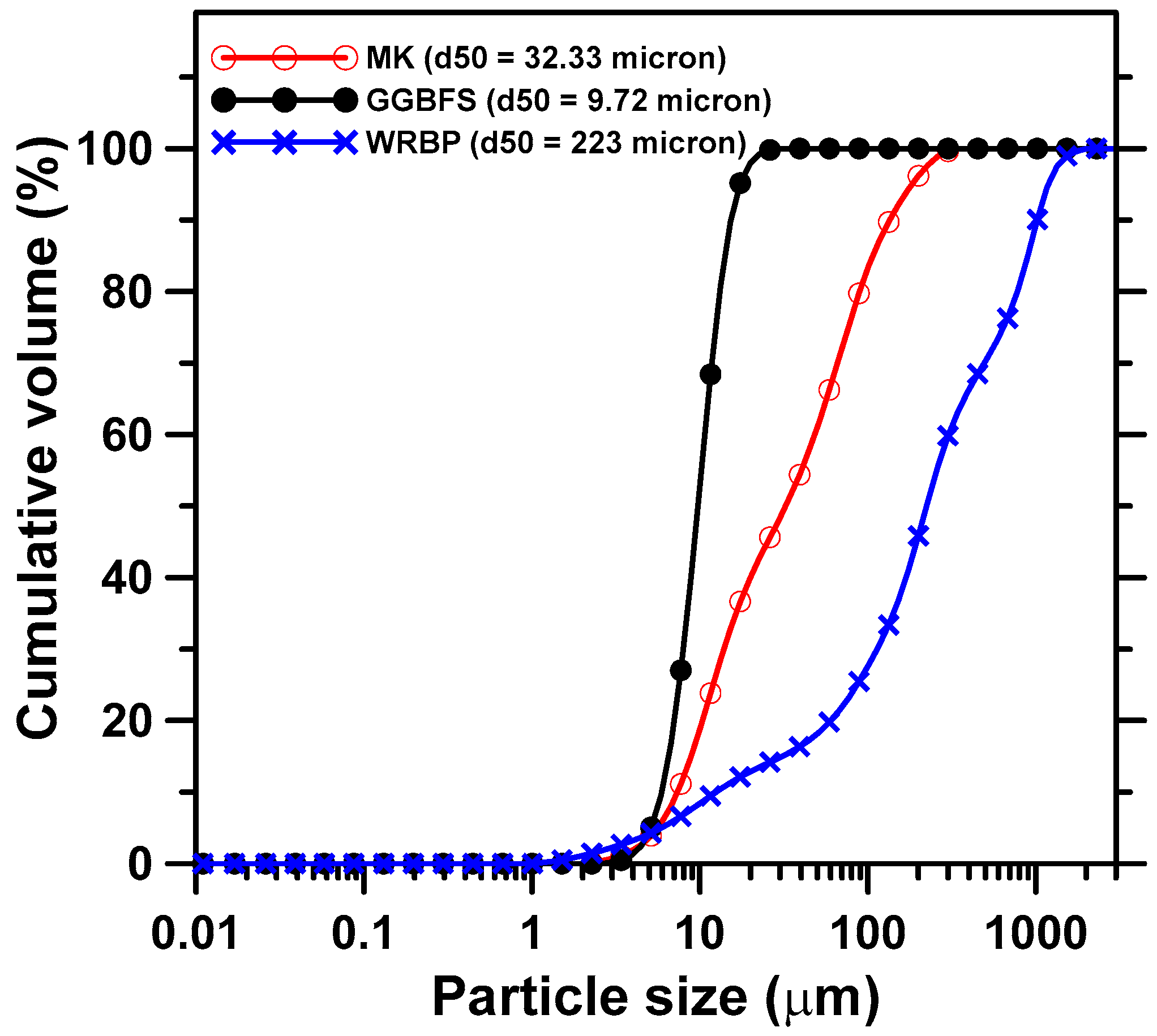
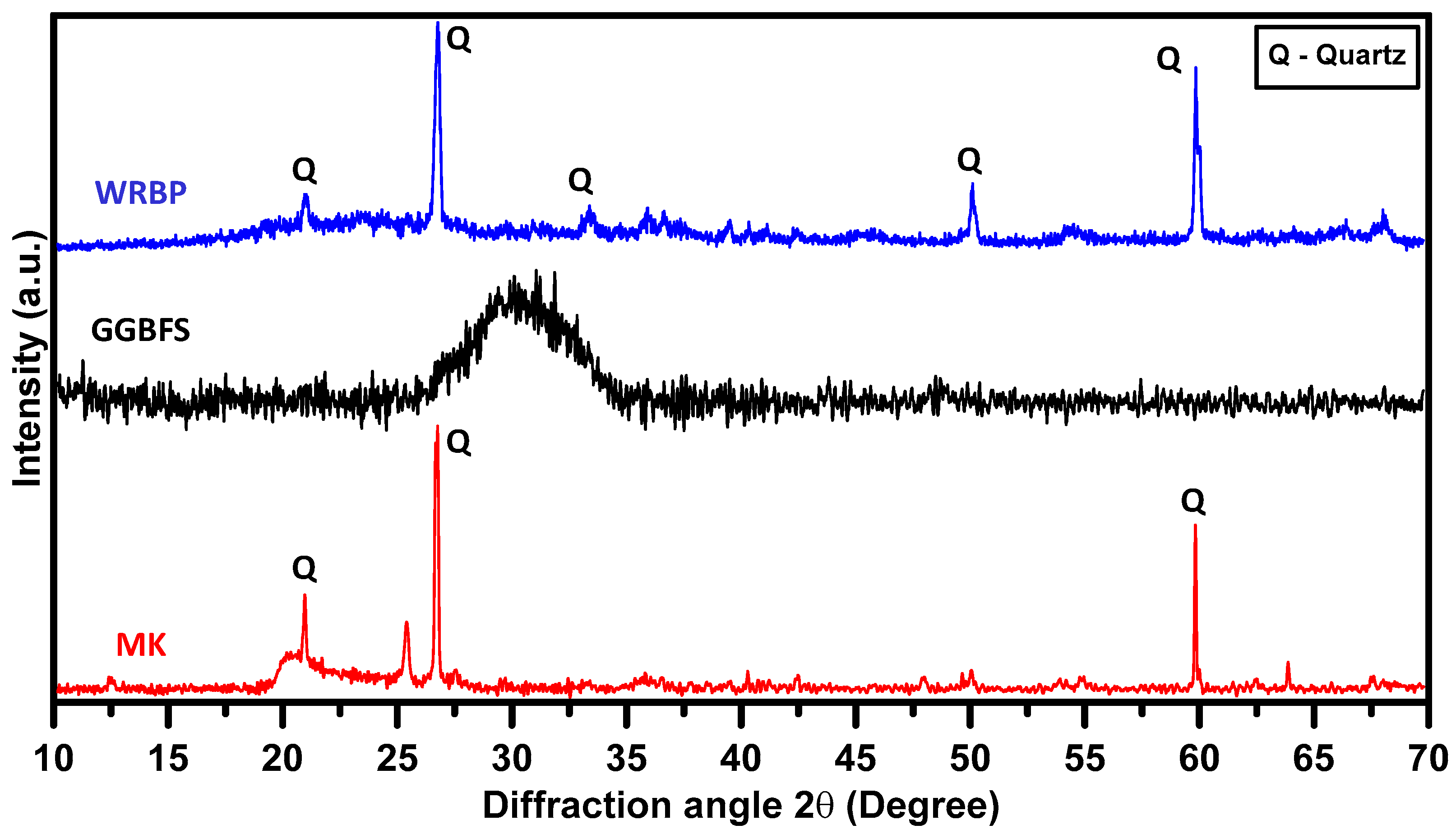
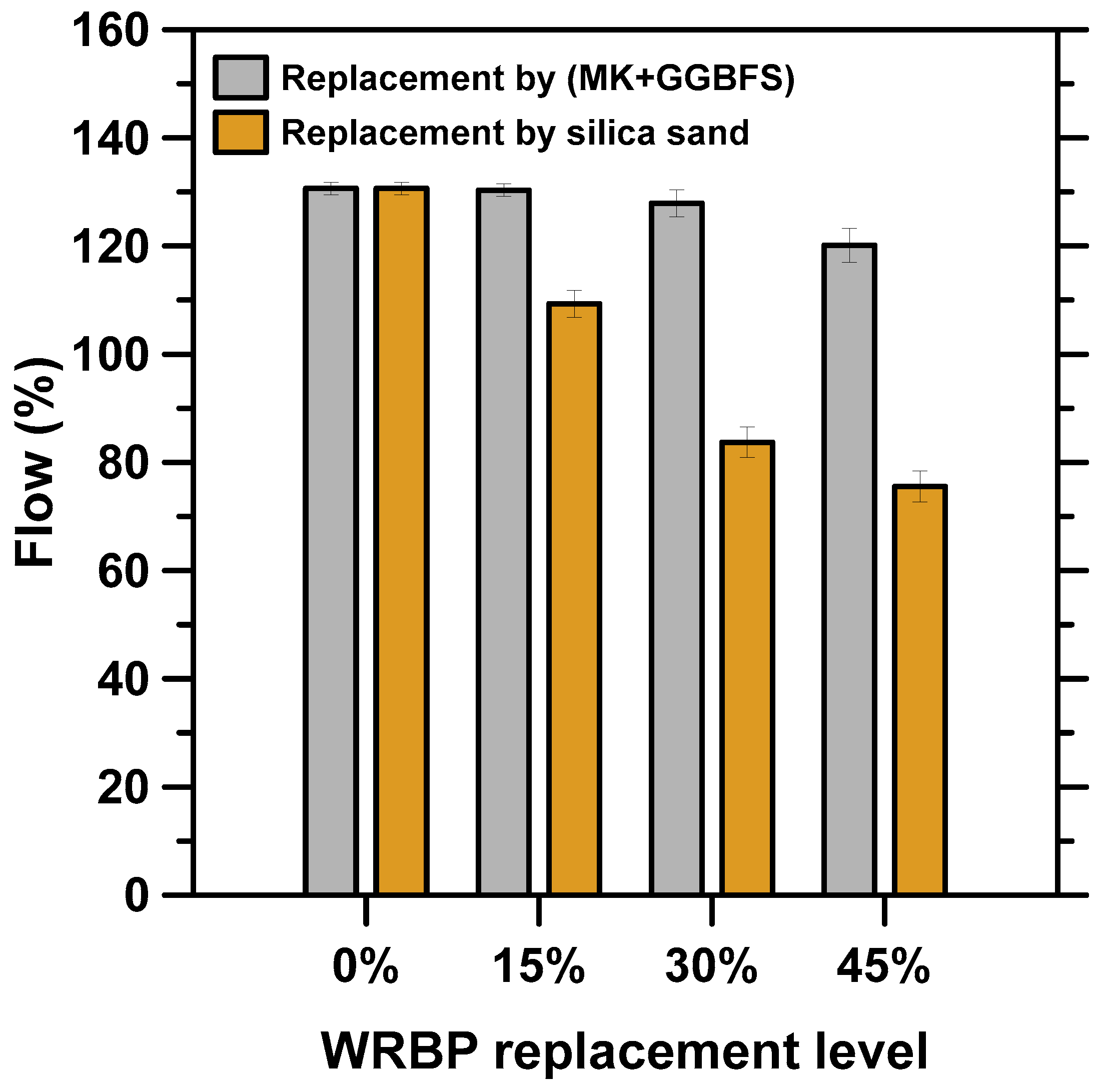
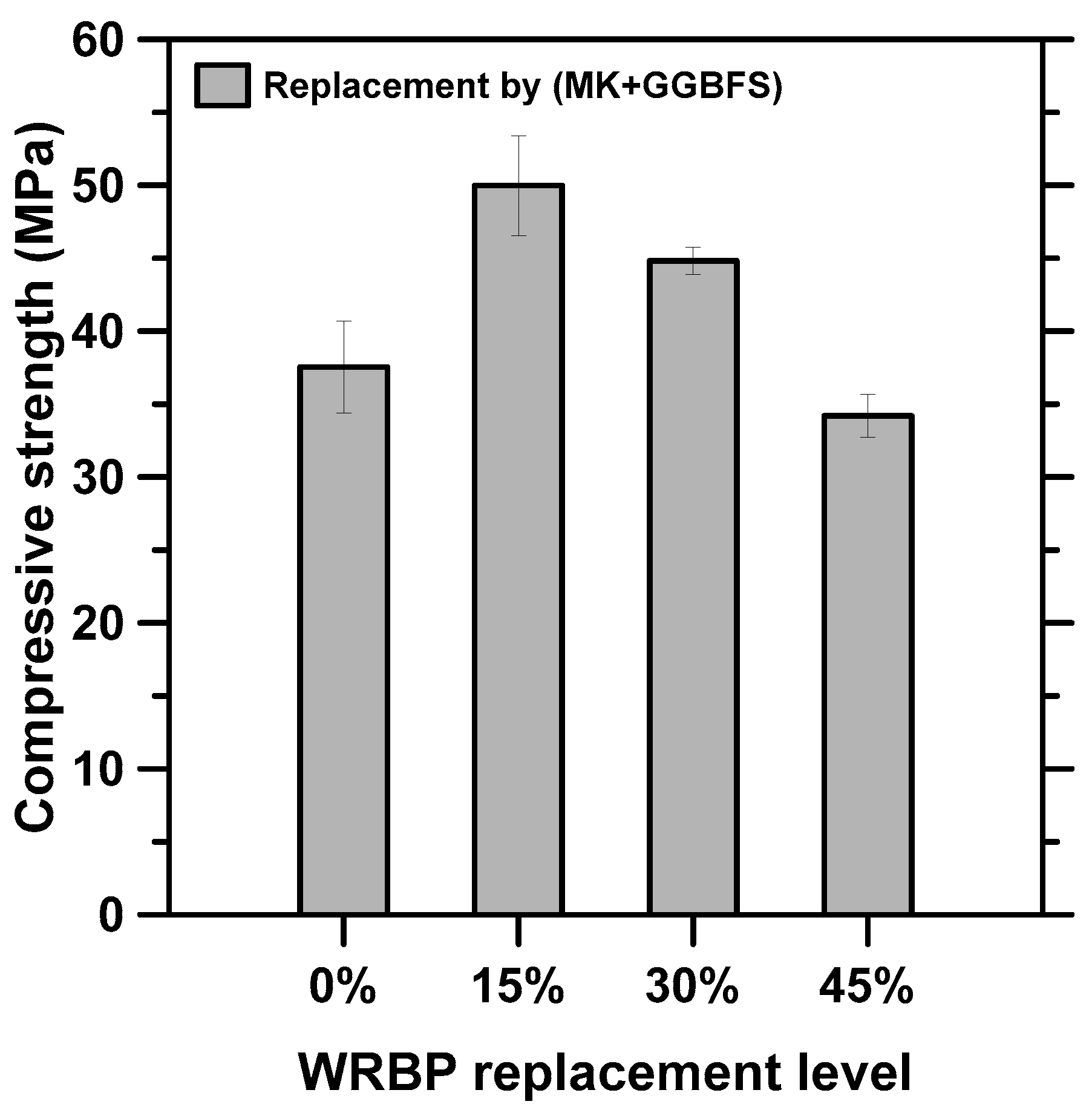

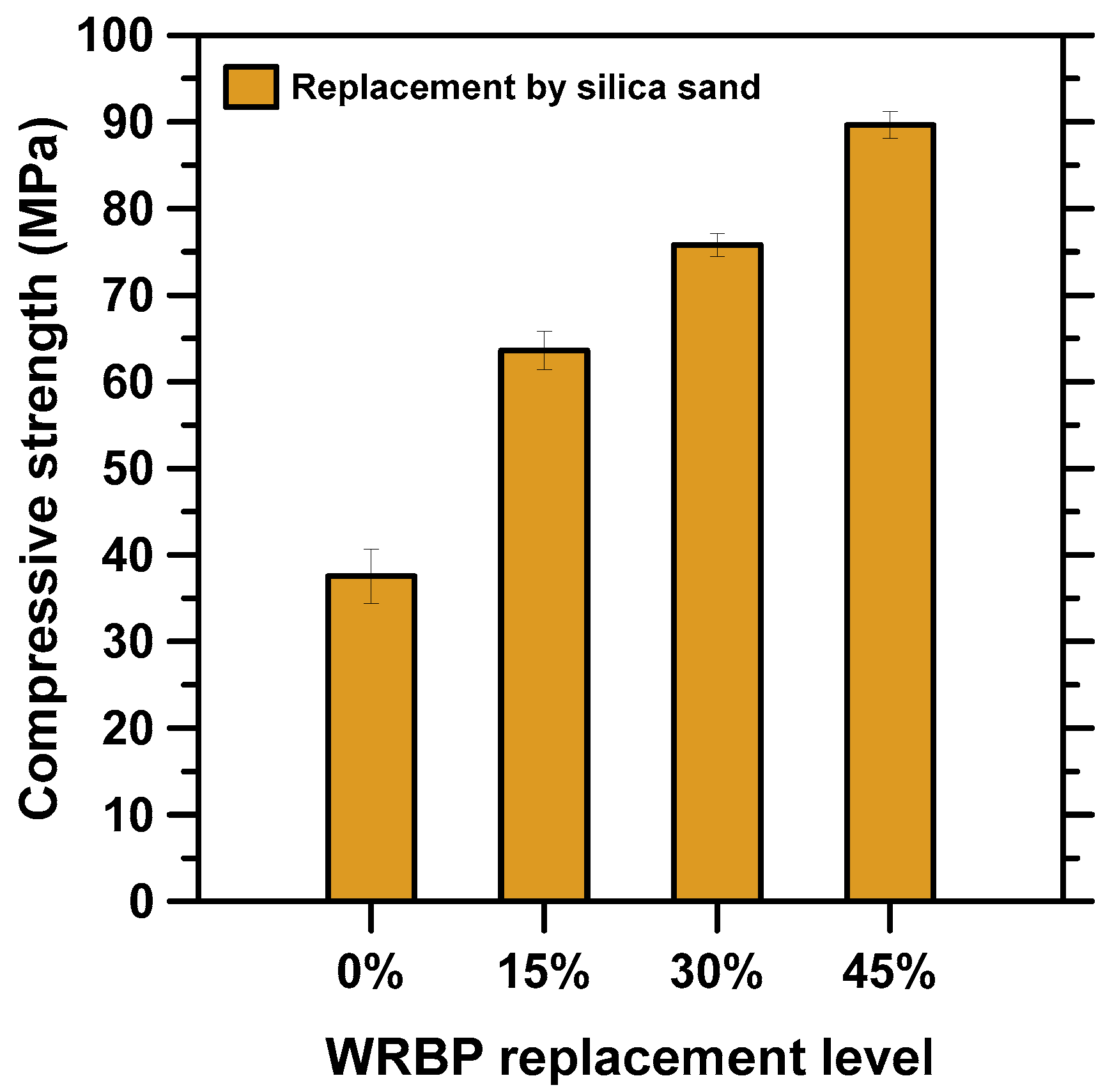
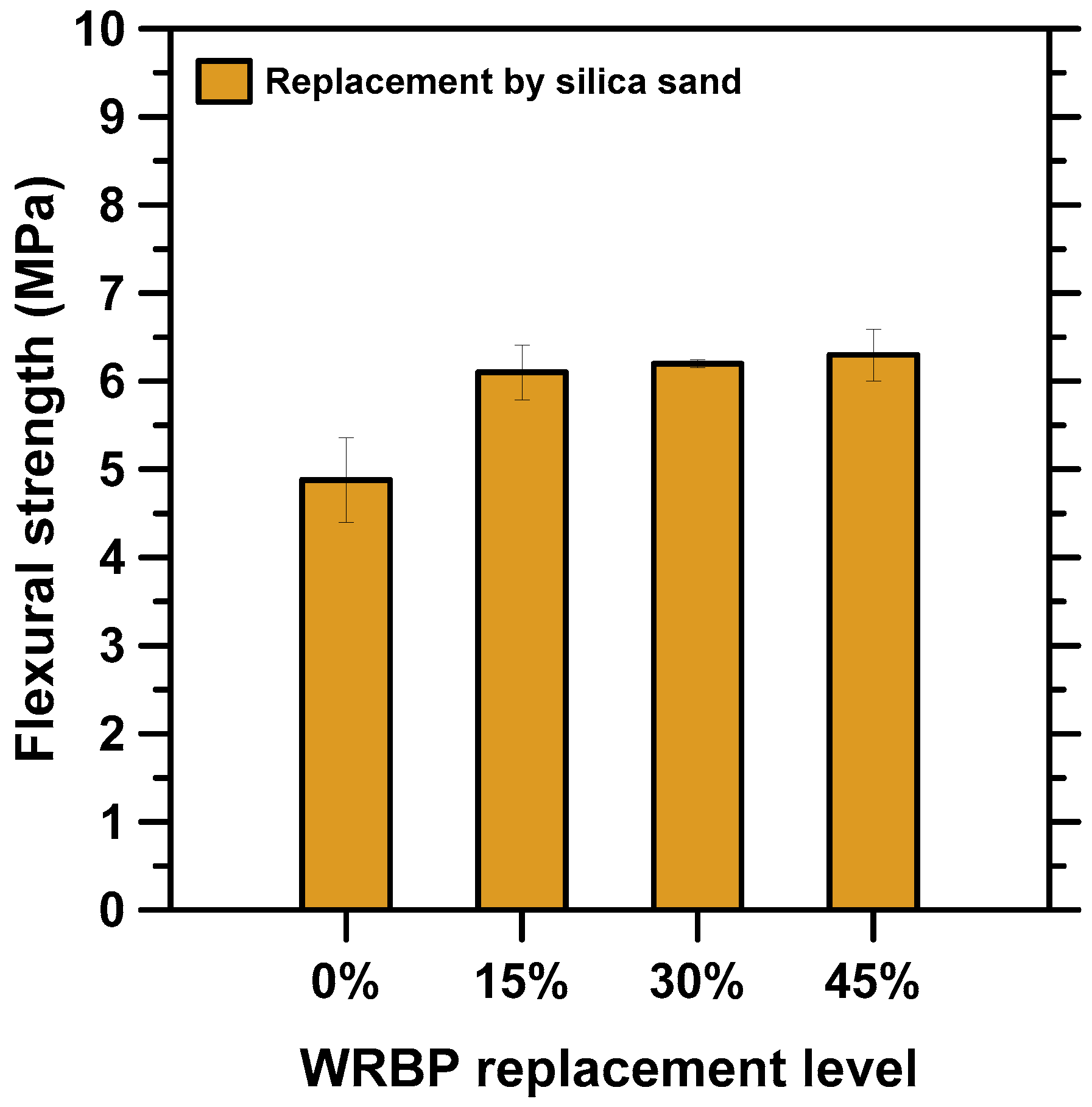
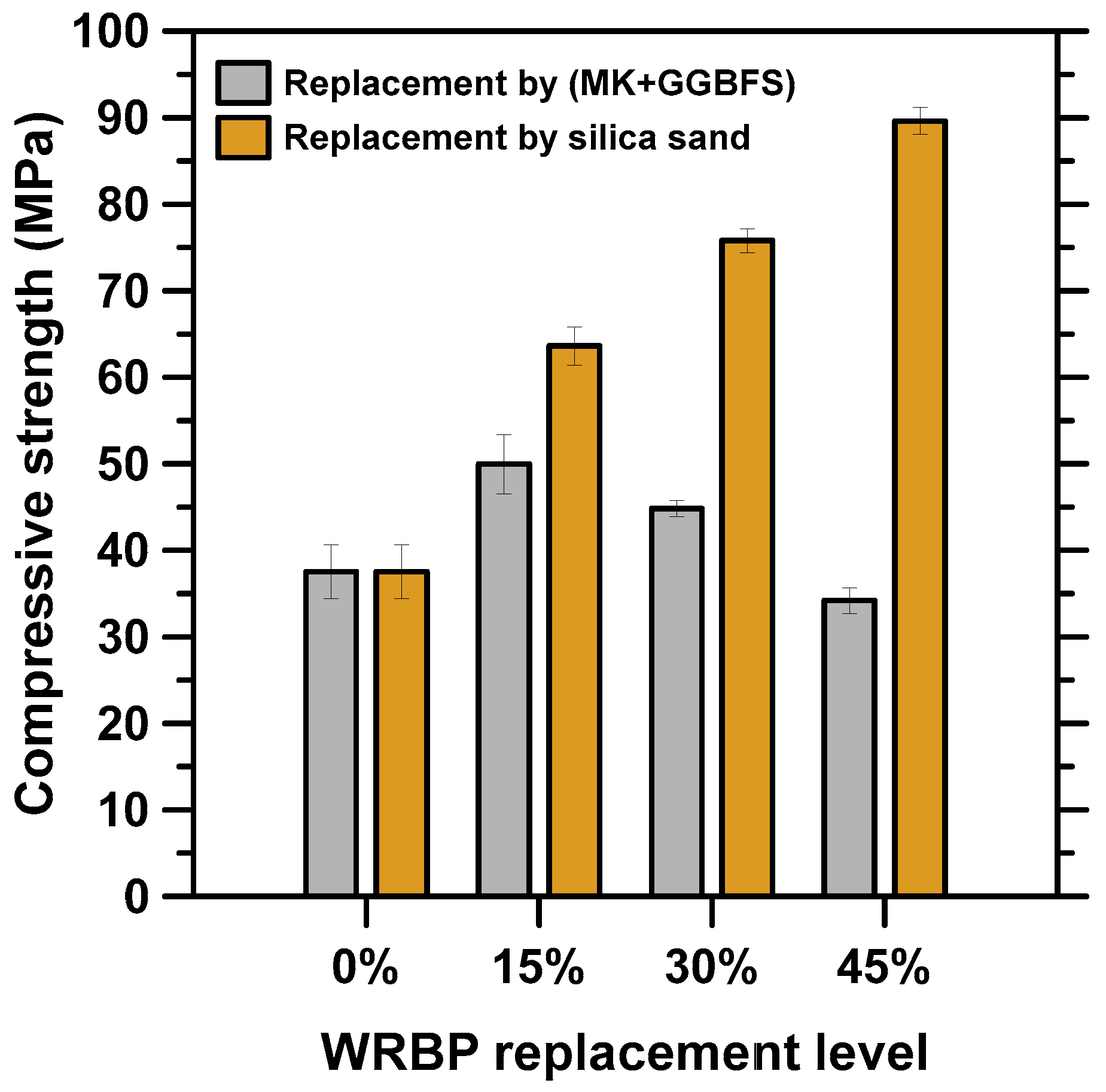
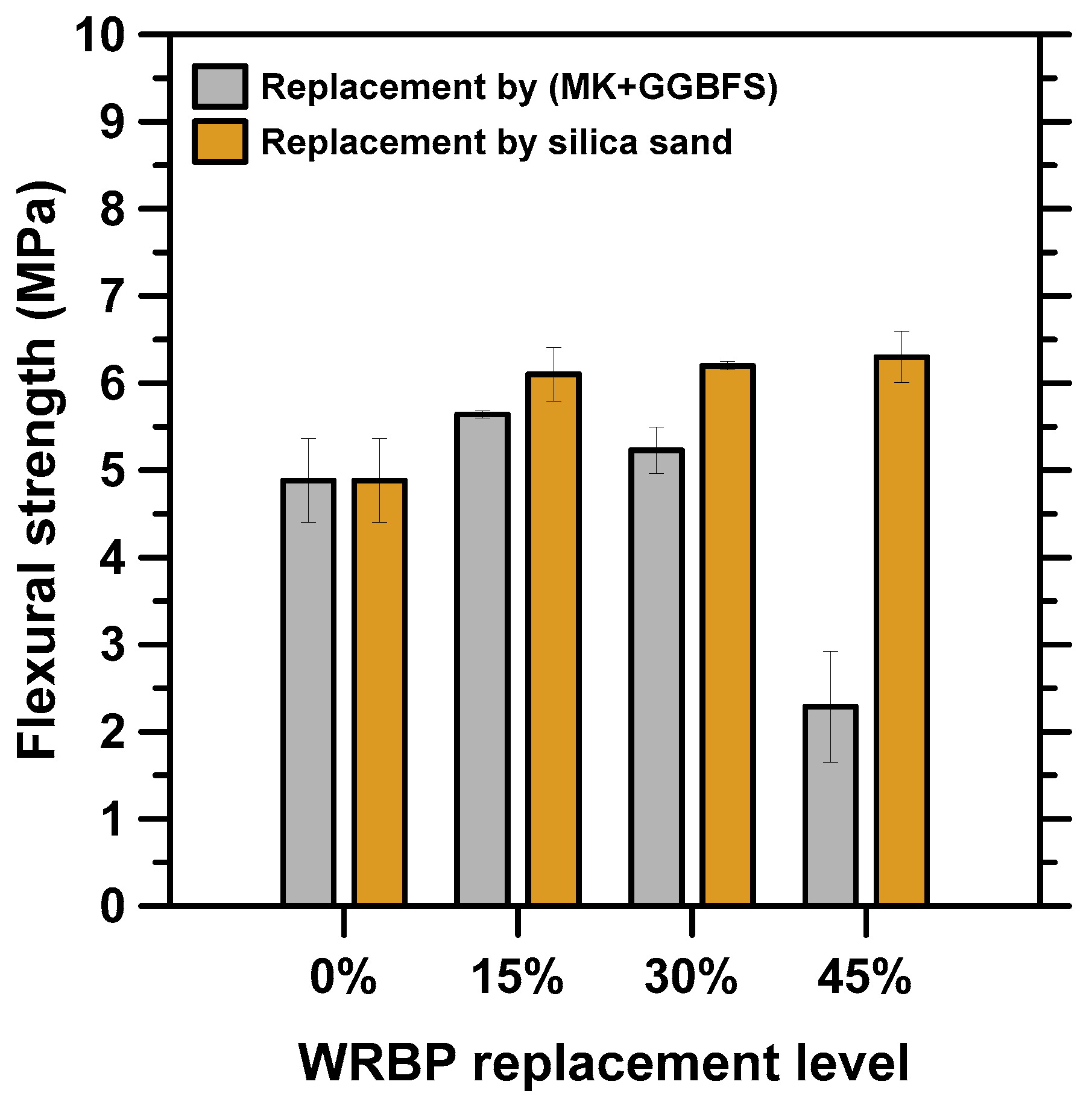
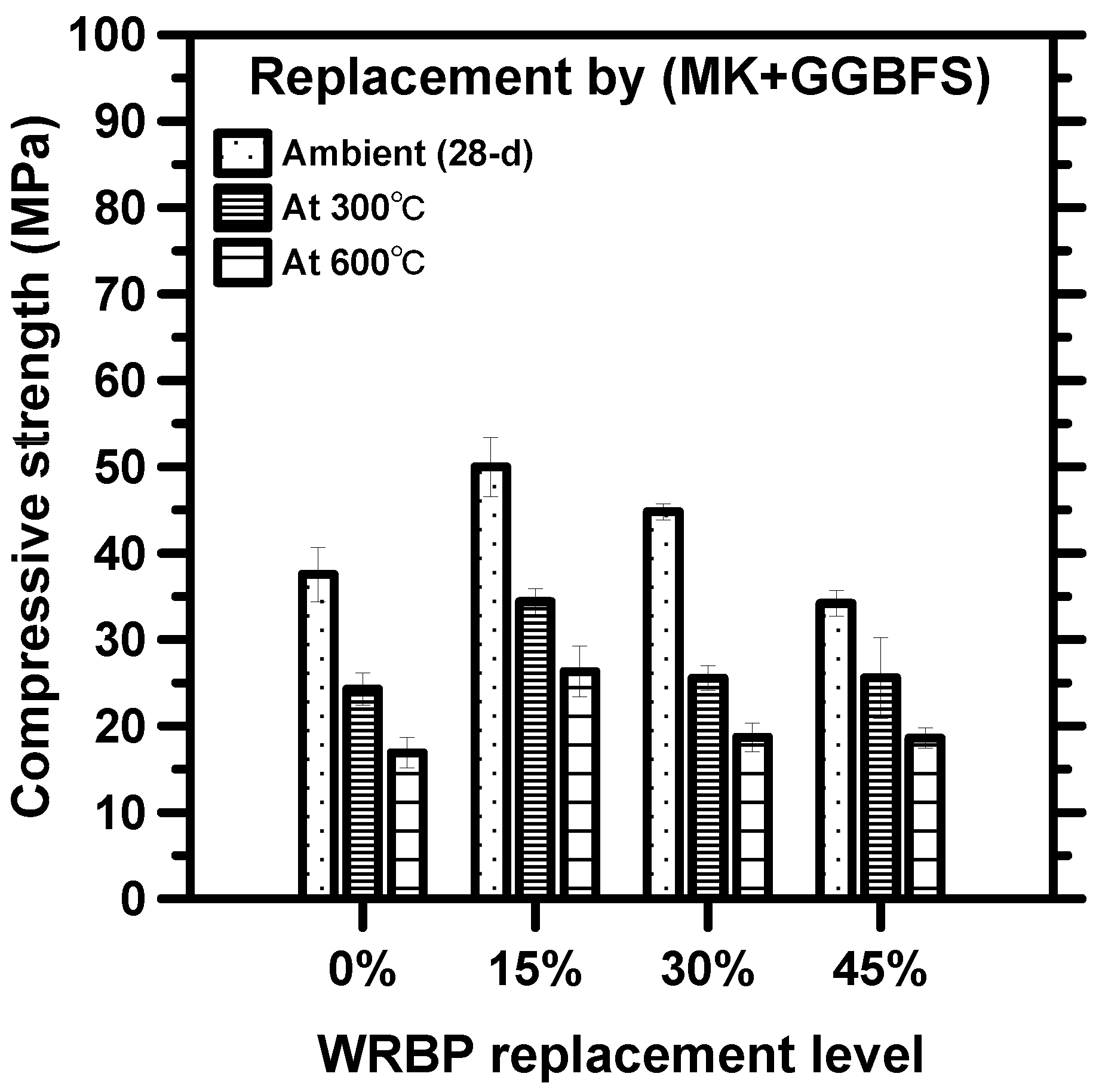

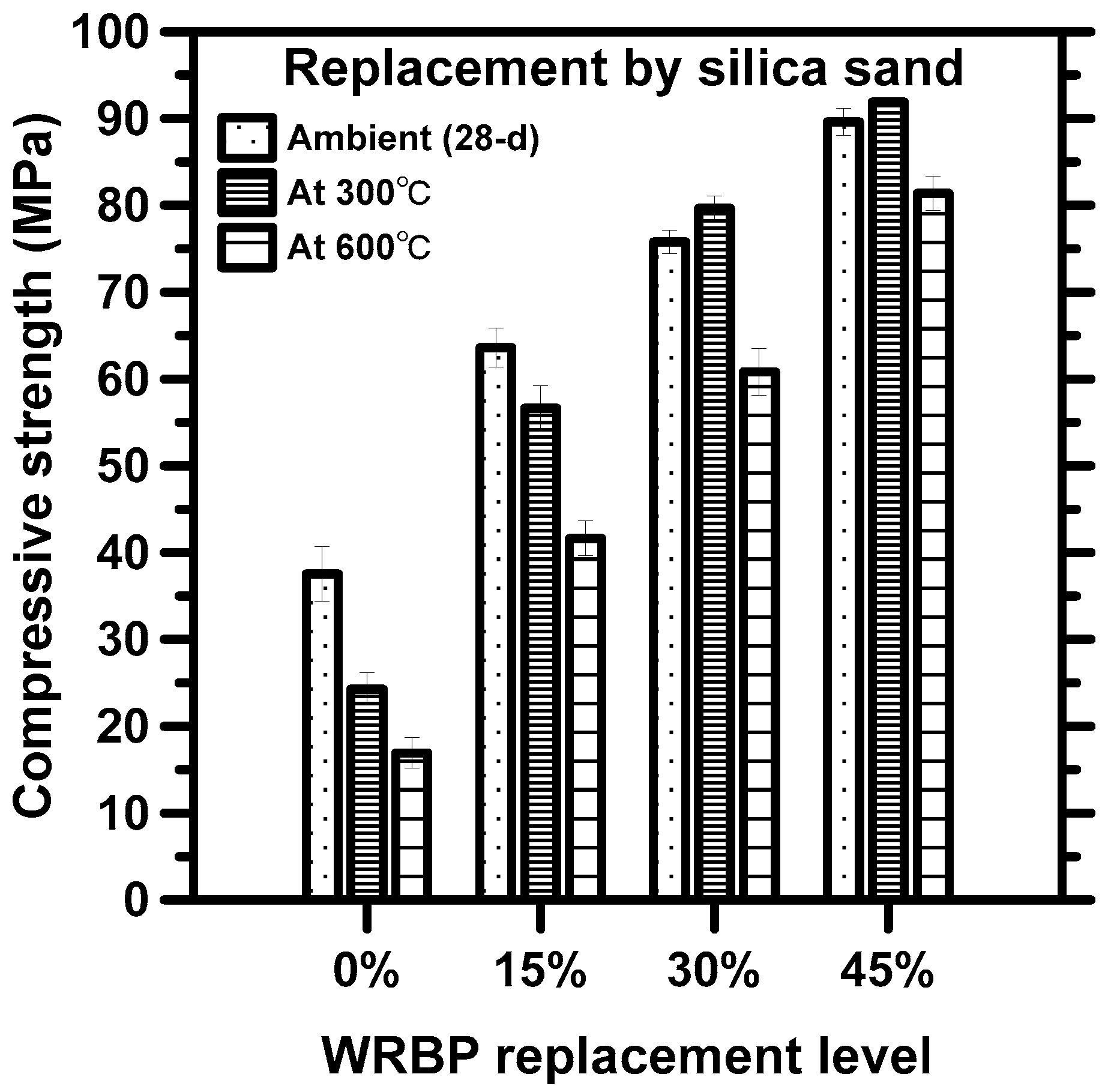
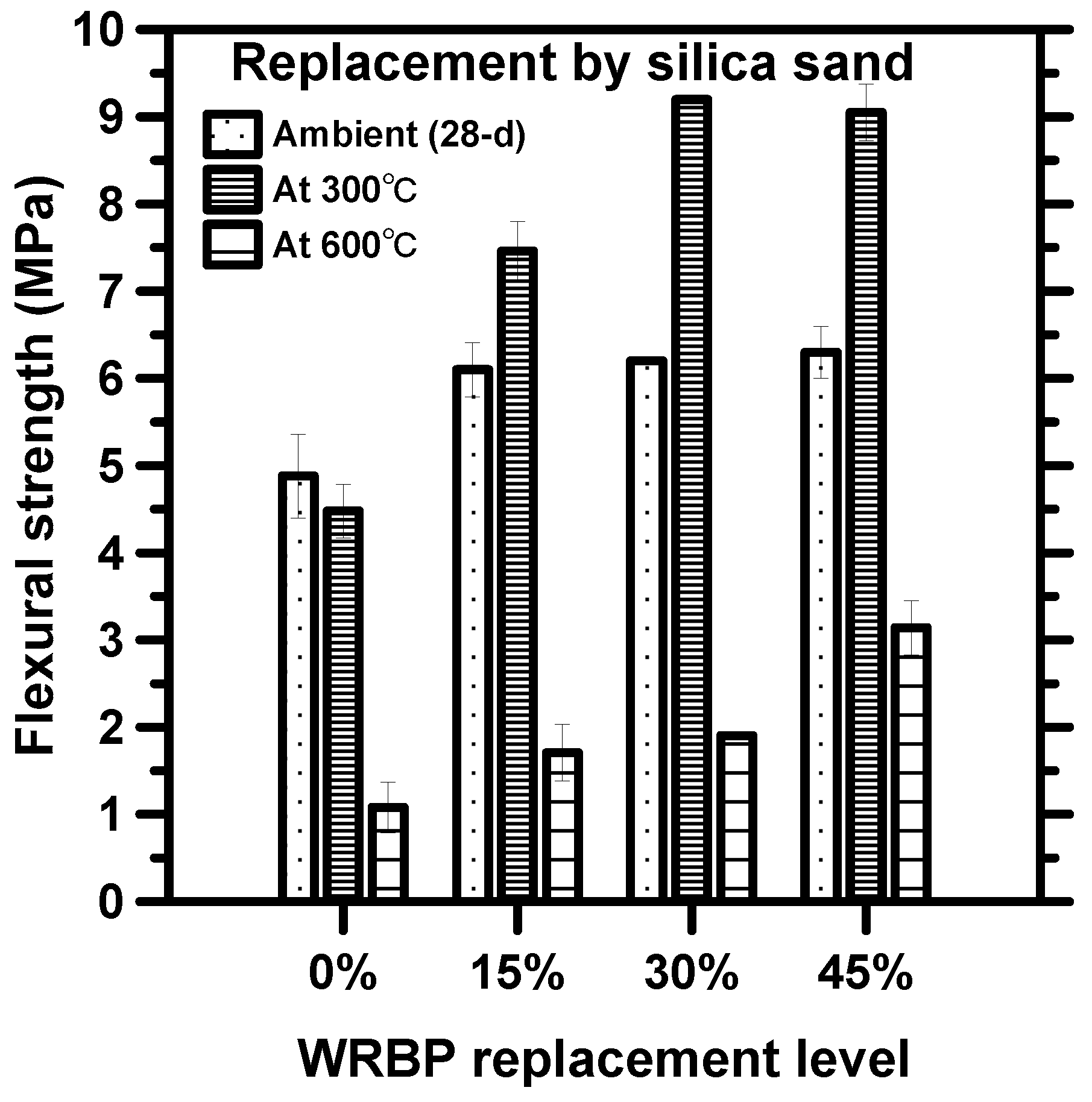
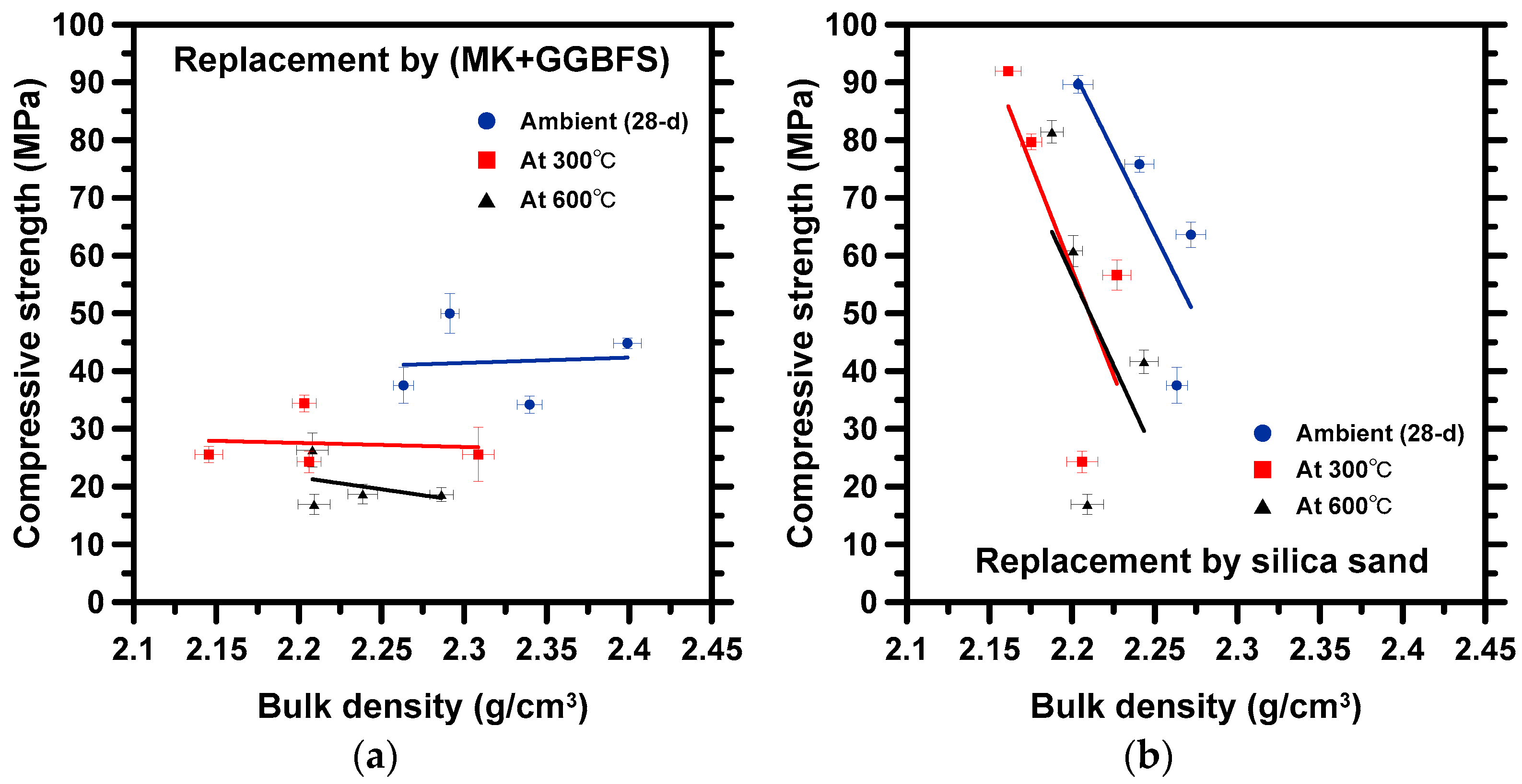
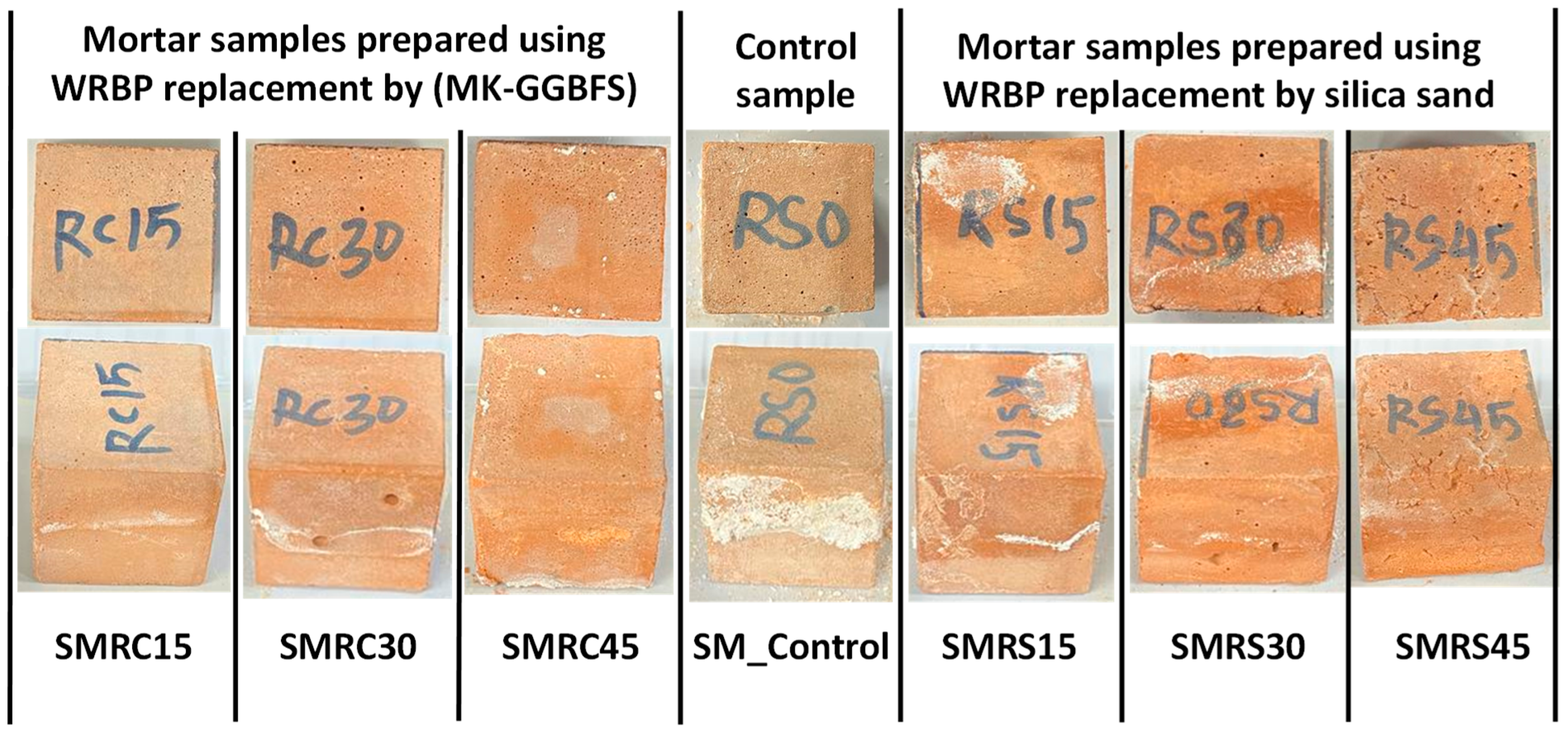
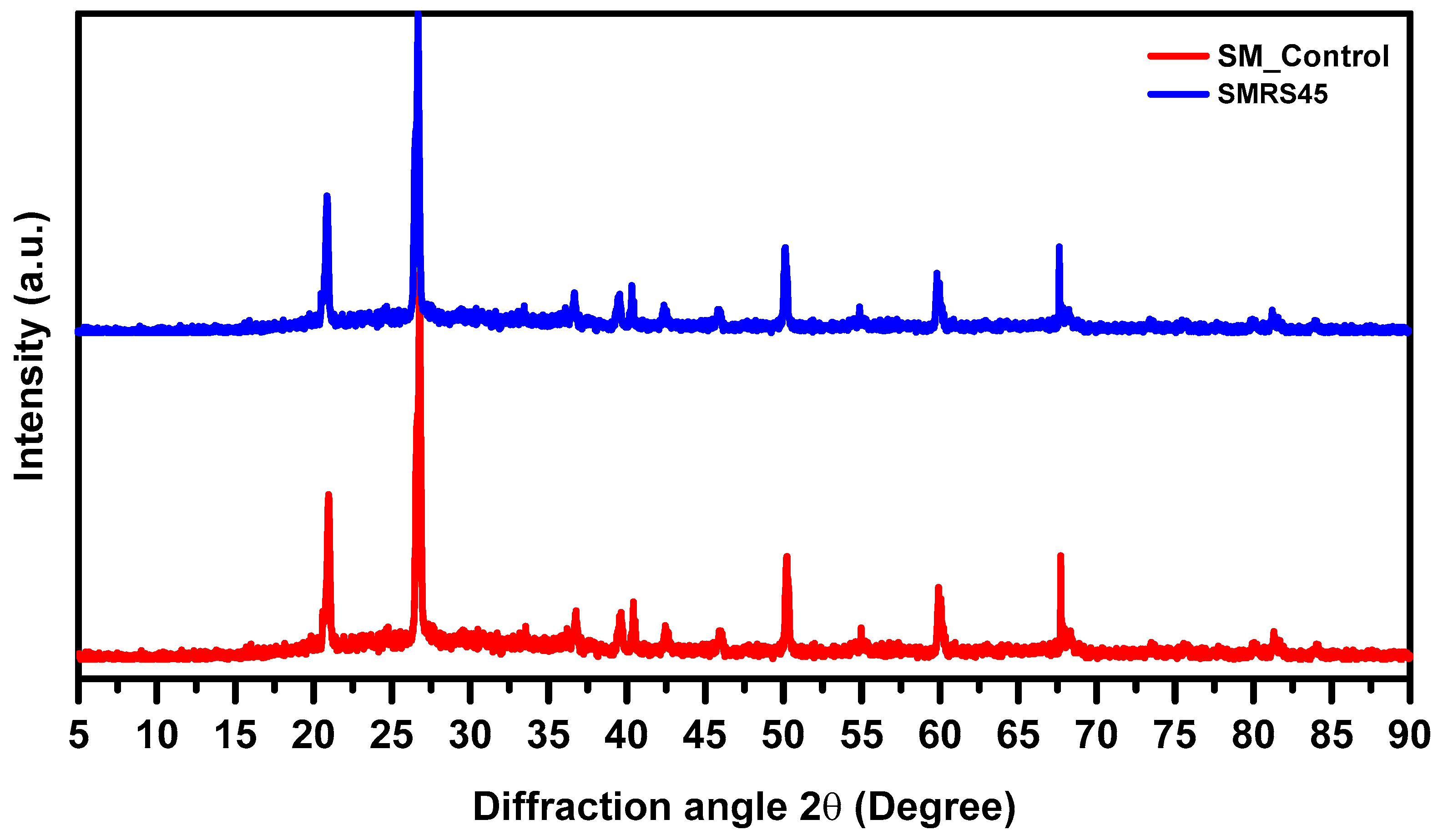
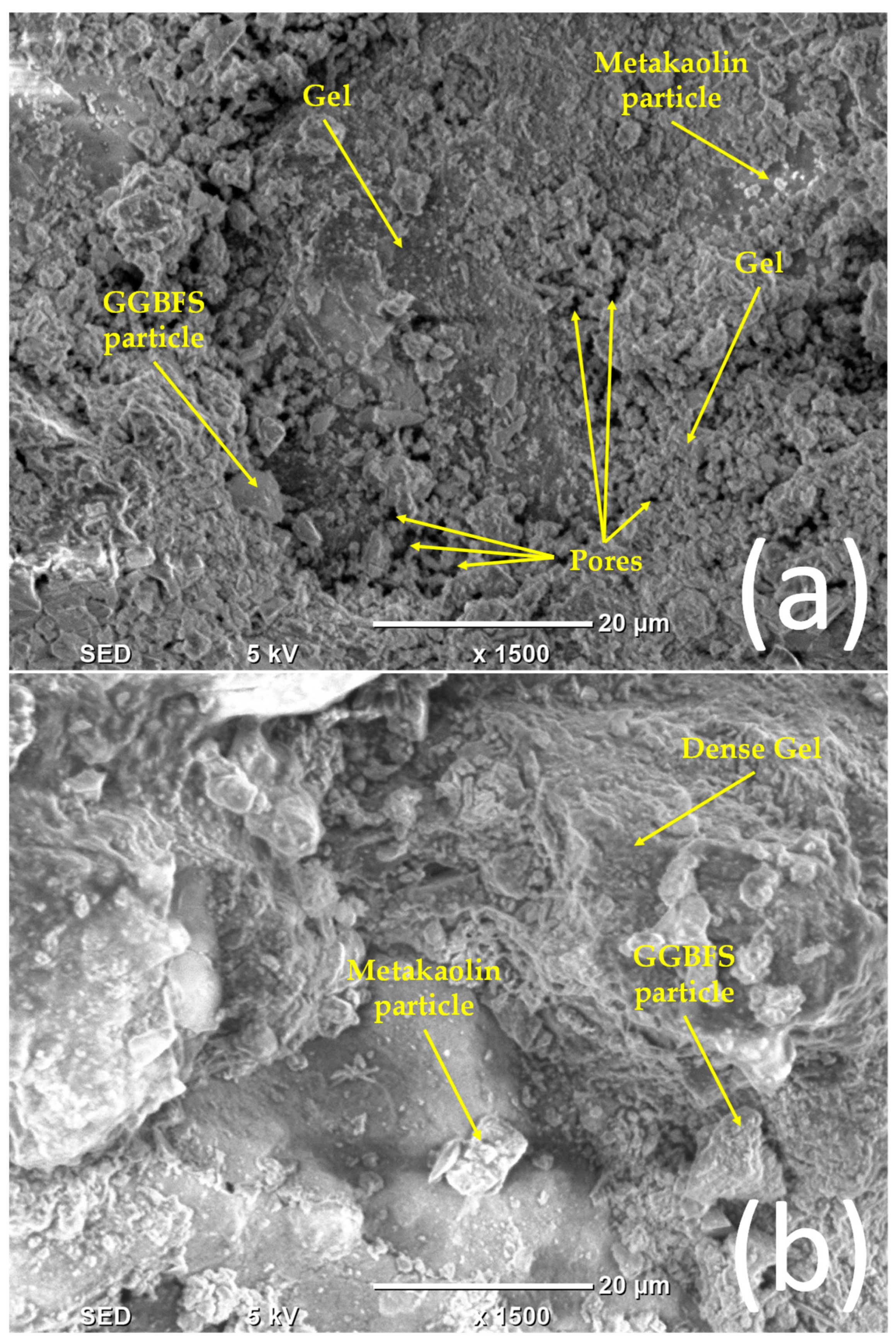
| Composition | MK | GGBFS | WRBP |
|---|---|---|---|
| CaO | 1.287 | 37.679 | 6.15 |
| SiO2 | 50.995 | 41.633 | 66.55 |
| Al2O3 | 42.631 | 16.857 | 14.80 |
| Fe2O3 | 2.114 | 0.144 | 5.48 |
| SO3 | 0.439 | 1.833 | -- |
| MgO | 0.127 | 1.184 | 2.39 |
| K2O | 0.337 | 0.360 | 2.13 |
| Na2O | 0.284 | 0.216 | -- |
| ZnO | 0.004 | 0.000 | -- |
| LOI | -- | -- | 1.48 |
| Scenarios | Sample ID | GGBFS (g) | MK (g) | WRBP (g) | Sodium Silicate (g) | NaOH (g) | Water (g) | Sand (g) |
|---|---|---|---|---|---|---|---|---|
| WRBP used as replacement (MK+GGBFS) | SM_Control | 500 | 500 | 0 | 729.0 | 73.0 | 192 | 2705 |
| SMRC15 | 425 | 425 | 150 | 729.0 | 73.0 | 192 | 2705 | |
| SMRC30 | 350 | 350 | 300 | 729.0 | 73.0 | 192 | 2705 | |
| SMRC45 | 275 | 275 | 450 | 729.0 | 73.0 | 192 | 2705 | |
| WRBP used as replacement by silica sand | SM_Control | 500 | 500 | 0 | 729.0 | 73.0 | 192 | 2705 |
| SMRS15 | 500 | 500 | 406 | 729.0 | 73.0 | 192 | 2299 | |
| SMRS30 | 500 | 500 | 812 | 729.0 | 73.0 | 192 | 1894 | |
| SMRS45 | 500 | 500 | 1217 | 729.0 | 73.0 | 192 | 1488 |
| Sample ID | Bulk Density (g/cm3) of Cured Specimens | ||
|---|---|---|---|
| At Ambient Temp. for 28 days | At 300 °C for 3 h | At 600 °C for 3 h | |
| SM control | 2.263 (0.006) | 2.206 (0.007) | 2.209 (0.010) |
| SMRC15 | 2.291 (0.006) | 2.203 (0.007) | 2.208 (0.010) |
| SMRC30 | 2.399 (0.008) | 2.145 (0.008) | 2.239 (0.009) |
| SMRC45 | 2.340 (0.008) | 2.309 (0.010) | 2.286 (0.007) |
| SM control | 2.263 (0.006) | 2.206 (0.009) | 2.209 (0.010) |
| SMRS15 | 2.272 (0.009) | 2.227 (0.009) | 2.243 (0.009) |
| SMRS30 | 2.241 (0.009) | 2.175 (0.006) | 2.201 (0.006) |
| SMRS45 | 2.204 (0.009) | 2.161 (0.008) | 2.188 (0.007) |
Disclaimer/Publisher’s Note: The statements, opinions and data contained in all publications are solely those of the individual author(s) and contributor(s) and not of MDPI and/or the editor(s). MDPI and/or the editor(s) disclaim responsibility for any injury to people or property resulting from any ideas, methods, instructions or products referred to in the content. |
© 2023 by the authors. Licensee MDPI, Basel, Switzerland. This article is an open access article distributed under the terms and conditions of the Creative Commons Attribution (CC BY) license (https://creativecommons.org/licenses/by/4.0/).
Share and Cite
Alghamdi, H.; Abadel, A.A.; Khawaji, M.; Alamri, M.; Alabdulkarim, A. Strength Performance and Microstructures of Alkali-Activated Metakaolin and GGBFS-Based Mortars: Role of Waste Red Brick Powder Incorporation. Minerals 2023, 13, 848. https://doi.org/10.3390/min13070848
Alghamdi H, Abadel AA, Khawaji M, Alamri M, Alabdulkarim A. Strength Performance and Microstructures of Alkali-Activated Metakaolin and GGBFS-Based Mortars: Role of Waste Red Brick Powder Incorporation. Minerals. 2023; 13(7):848. https://doi.org/10.3390/min13070848
Chicago/Turabian StyleAlghamdi, Hussam, Aref A. Abadel, Mohammad Khawaji, Mohammed Alamri, and Abdullah Alabdulkarim. 2023. "Strength Performance and Microstructures of Alkali-Activated Metakaolin and GGBFS-Based Mortars: Role of Waste Red Brick Powder Incorporation" Minerals 13, no. 7: 848. https://doi.org/10.3390/min13070848
APA StyleAlghamdi, H., Abadel, A. A., Khawaji, M., Alamri, M., & Alabdulkarim, A. (2023). Strength Performance and Microstructures of Alkali-Activated Metakaolin and GGBFS-Based Mortars: Role of Waste Red Brick Powder Incorporation. Minerals, 13(7), 848. https://doi.org/10.3390/min13070848







